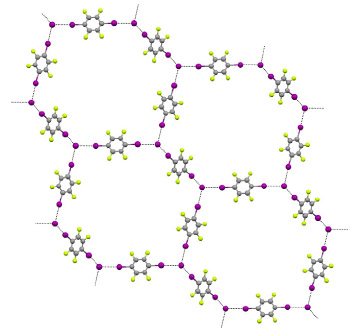
The single crystal structures of five co-crystals formed by the reaction of different iodide and bromide salts with di- and triiodoperfluorobenzenes (I-ArF) are reported. All of these perfluorocarbonhydrocarbon systems are heteromeric three-component systems, wherein the weakly coordinating cations favour the formation of naked halides, which function as electron-donors towards the I-ArF modules. The analysis of the crystal structures shows that I-...I?ArF, and Br-...I?ArF halogen bonds
(XBs) control the self-assembly of the obtained supramolecular architectures. 2D and 3D supramolecular networks have been obtained, wherein naked iodide and bromide anions act as tri-, tetra-, or pentadentate nodes. The selected examples demonstrate that I-ArF modules can be particularly robust and reliable tectons for XB-based coordination of halide ions and afford supramolecular architectures in a rational and predictable way.